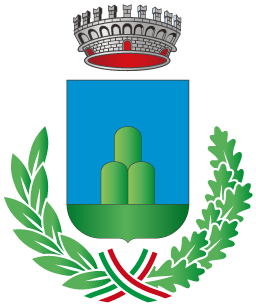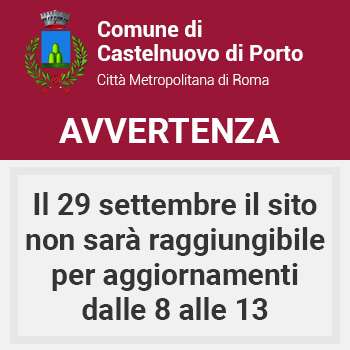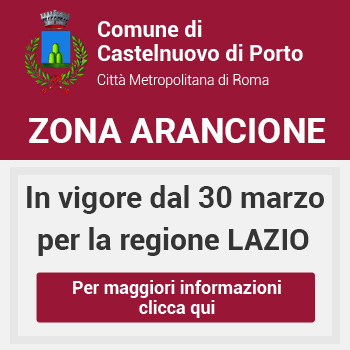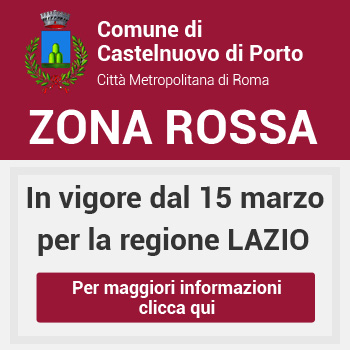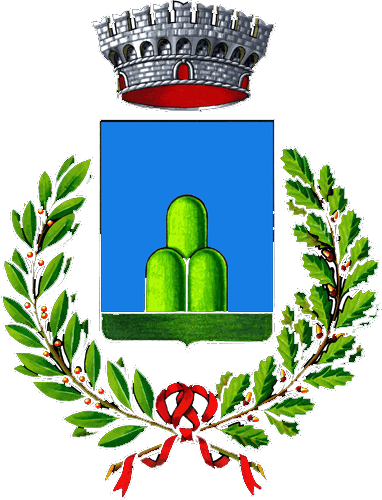Virtual tour
The Ducal Palace of Castelnuovo di Porto, commonly called “Rocca Colonna” is the result of the transformation that has undergone over time from a fortified military settlement to a Renaissance palace. Located on the tuffaceous spur between the valley of the Chiarano and Mola ditch, it occupies the highest point of the ancient village from which it is isolated, in a prominent position, but in close relationship with the surrounding town. The ancient village over the centuries has developed around the castle in concentric circles and maintains the typical medieval structure. The Rocca looks like a massive architectural complex which is accessed from the main square through two flights of stairs that, following the ancient access ramp, connote the facade along with the two side towers. The Tower to the East, was indicated by Clementi and Panepuccia in the book “Castelnuovo città e territorio” like the old keep and represents the oldest part of the fortified settlement, while the west one was built in a backward position where it was the revealing to harmonize the facade.
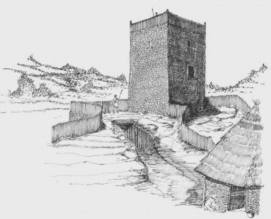 Uncertain are the origins of the oldest nucleus that supposedly stood on an oppidum capenate. The name “Castelnuovo di Porto” seems to suggest the reconstruction of “New Castle” probably by the Benedictine monks of San Paolo. The first castle was built before the year 1000 by the Roman prince and senator Alberico, son of Marozia. Occupied by Stephen of Theobald, in 1139 Pope Innocent II gave it back to the Monastery of Saint Paul. Already in 1252 the Fortress appears among the properties of the Colonna family as a garrison and advanced point in a strategic position to the north. Stefano Colonna was responsible for the fortification works. The greatest Colonnese power was reached under the pontificate of Martin V (1417-1431). In 1435 the troops of Cardinal Vitelleschi conquered Castelnuovo where Nicolò Fortebraccio had settled after destroying the castle of Monte La Guardia near Morlupo. In 1477 Nicolò returned it to the Colonna family but in 1501 it was occupied by Alessandro VI Borgia who garrisoned the castle with fortified artillery structures. After the death of the Borgian pope, in 1504 he returned to Giovanni di Odoardo Colonna. that he did his utmost to end hostilities with the nearby Civitella San Paolo. Stefano and Alessandro Di Francesco, lords of Castelnuovo, in 1518, had the quarrel with Vittoria di Zagarolo and Laura Somma over the rights of various castles. To settle this controversy over the possession of a castrumnovumportuensis, Pope Paul III intervened in 1548. On December 10, 1548 Sciarra Colonna decreed the Statutes that regulated the market, the courts, the justice.
Uncertain are the origins of the oldest nucleus that supposedly stood on an oppidum capenate. The name “Castelnuovo di Porto” seems to suggest the reconstruction of “New Castle” probably by the Benedictine monks of San Paolo. The first castle was built before the year 1000 by the Roman prince and senator Alberico, son of Marozia. Occupied by Stephen of Theobald, in 1139 Pope Innocent II gave it back to the Monastery of Saint Paul. Already in 1252 the Fortress appears among the properties of the Colonna family as a garrison and advanced point in a strategic position to the north. Stefano Colonna was responsible for the fortification works. The greatest Colonnese power was reached under the pontificate of Martin V (1417-1431). In 1435 the troops of Cardinal Vitelleschi conquered Castelnuovo where Nicolò Fortebraccio had settled after destroying the castle of Monte La Guardia near Morlupo. In 1477 Nicolò returned it to the Colonna family but in 1501 it was occupied by Alessandro VI Borgia who garrisoned the castle with fortified artillery structures. After the death of the Borgian pope, in 1504 he returned to Giovanni di Odoardo Colonna. that he did his utmost to end hostilities with the nearby Civitella San Paolo. Stefano and Alessandro Di Francesco, lords of Castelnuovo, in 1518, had the quarrel with Vittoria di Zagarolo and Laura Somma over the rights of various castles. To settle this controversy over the possession of a castrumnovumportuensis, Pope Paul III intervened in 1548. On December 10, 1548 Sciarra Colonna decreed the Statutes that regulated the market, the courts, the justice.
On the death of Clarice Anguillara Colonna, wife of Sciarra, since 1581 Castelnuovo and its fortress are sold to the Holy See and are administered by commissioners of the Apostolic Chamber. In 1627 the castle was awarded to Scipione Degli Effetti. Many were the stays at the Fortress of illustrious personalities including at the end of the seventeenth century that of Queen Christina of Sweden and in 1734 of Charles III of Bourbon as he went to the conquest of the Kingdom of Naples. Since 1870 the castle has been the seat of the magistrate’s court and prison, a function it maintained until the first half of the last century.
The original nucleus built by the monks of San Paolo f.l.m. was in 1290 Giacomo Colonna called Sciarra, known as the architect of the “slap of Anagni“, who added a tower of rivellino of which the remains are visible “decapitated” and a protected walkway that connected it to the fortress, of which only traces are visible today in the walls to the west of the body of the castle. In this period were created living rooms and embellished the Chapel of San Silvestro in Castello. The chapel already mentioned in a papal bull of John XIX of 1026 – “Ancient church of San Silvestro in Colonna which is in the courtyard of the Rocca di Castelnuovo” is since then linked to the Colonna family. The small chapel has only come to light a few years ago, when a careful restoration freed the complex of frescoes from heavy dull of different colors that concealed them. The small room (3,60 3,29) is completely frescoed both on the walls and in the vault that hosts, in its four segments, the frescoes of the four evangelists each represented its own specific symbology. Starting from the representation of New Year’s Eve, this lunette houses a triptych of saints: Saint Leonard of Noblac, protector of prisoners and unjustly imprisoned (in case the chapel was used as a meeting room during the period of use as a prison) represented with shackles; New Year’s Eve crushing the dragon of paganism and Saint Anthony with the bell.
Above the three Saints an “almond” supported by two angels contains the portrait of Christ. On the left wall a large fresco represents the virgin with the child at her feet is kneeling Saint Catherine of Alexandria and in the background Saint Martin. Above the figures stands a crucifixion. The right wall in which the original entrance was inserted, shows only partial frescoes in the middle band of the wall and you can see in the left corner the figure of a knight. Above a fresco with rare iconography and probably unique in territorial context, it represents Christ Crucified in the arms of God the Father. The back wall, in which a second entrance door opened in a later period, was once adorned with a fresco depicting the baptism of Jesus. Unfortunately, only a few details of this fresco remain in which the figure of Jesus, the Baptist and an angel with large wings are recognized. At one time the halos of the saints were adorned with stones and pearls. In 1548 Alessandro Colonna grants the feud to his son Sciarra who continues the building transformations already undertaken by his father and completes the work of transforming the fortress into a Renaissance palace with the realization of important works tar which the construction of a new piano nobile.
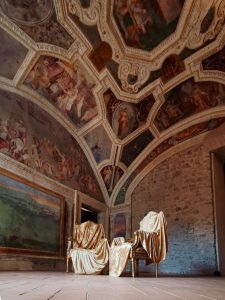 In this period the palace is permanently inhabited by Sciarra, his wife Clarice Anguillara and their children and Mambrino Roseo, a scholar, tutor before the young Clarice and then his children. The most significant intervention of the period is the Loggia Pinta (once a loggia with two open arches; then the one that looks at the square was closed), dated 1568 and attributed to Federico Zuccari. The frescoes that adorn both on the walls and on the vault represent the Virtues, the Seasons and salient episodes of the history of Rome: the arrival of Aeneas, the battles of Benevento and Zama, a large port with ruins of Roman monuments one of which has been identified as the temple of Minerva Medica and gradually heroic scenes and historical moments.
In this period the palace is permanently inhabited by Sciarra, his wife Clarice Anguillara and their children and Mambrino Roseo, a scholar, tutor before the young Clarice and then his children. The most significant intervention of the period is the Loggia Pinta (once a loggia with two open arches; then the one that looks at the square was closed), dated 1568 and attributed to Federico Zuccari. The frescoes that adorn both on the walls and on the vault represent the Virtues, the Seasons and salient episodes of the history of Rome: the arrival of Aeneas, the battles of Benevento and Zama, a large port with ruins of Roman monuments one of which has been identified as the temple of Minerva Medica and gradually heroic scenes and historical moments.
The restoration of the pictorial cycle then brought to light new frescoes pertinent to the original cycle remained for centuries covered by layers of repainting. Beneath the vault, adorned with historical panels referring to episodes of Roman history, are the paintings of a lunette originally containing the arch that overlooked the square as well as the paintings of the walls below painted with landscapes that reproduced the feuds of the client. From archive documents the date of execution of the cycle is attested to 1568 and this has allowed to attribute the realization to a specific moment of the activity of Frederick with precise feedback on the level of style with works of the period.
